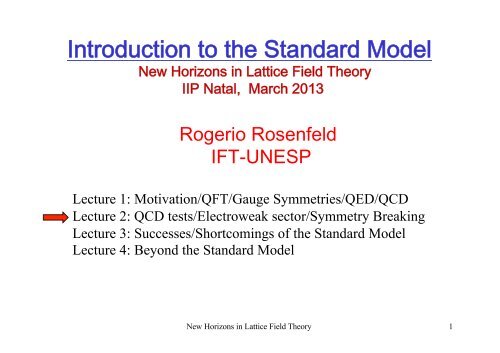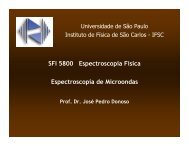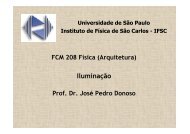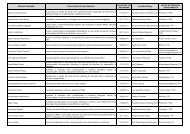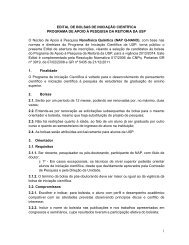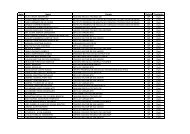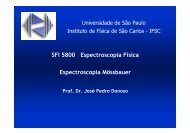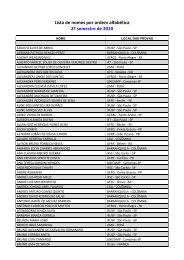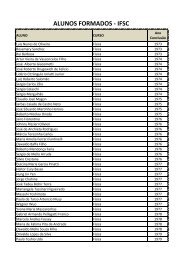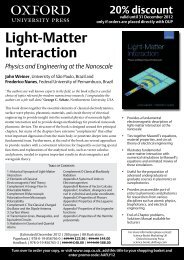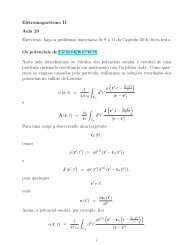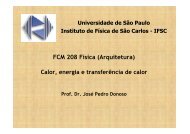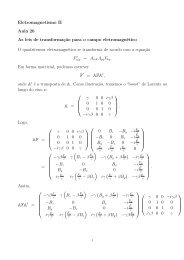You also want an ePaper? Increase the reach of your titles
YUMPU automatically turns print PDFs into web optimized ePapers that Google loves.
Introduction to the Standard Model<br />
New Horizons in Lattice Field Theory<br />
IIP Natal, March 2013<br />
Rogerio Rosenfeld<br />
IFT-UNESP<br />
<strong>Lecture</strong> 1: Motivation/QFT/Gauge Symmetries/QED/QCD<br />
<strong>Lecture</strong> 2: QCD tests/Electroweak sector/Symmetry Breaking<br />
<strong>Lecture</strong> 3: Successes/Shortcomings of the Standard Model<br />
<strong>Lecture</strong> 4: Beyond the Standard Model<br />
New Horizons in Lattice Field Theory 1
QCD lagrangian<br />
+✓ Tr<br />
⇣F µ⌫ ˜Fµ⌫ ⌘<br />
θ term is allowed by gauge symmetries but violates CP.<br />
It arises from the vacuum structure of QCD.<br />
It can also affect perturbative calculations (jets ang. dist.)<br />
Strong bounds from neutron electric dipole moment.<br />
Strong CP problem.<br />
Solution may be related to Dark Matter in the universe!<br />
New Horizons in Lattice Field Theory 2
M. Romalis talk<br />
QCD sum rules<br />
New Horizons in Lattice Field Theory 3
Hadrons: mesons (qq) and baryons (qqq or qqq) color<br />
neutral (color singlet) states.<br />
Strong interactions among hadrons is a residual effect analogue to<br />
the van der Waals force between electrically neutral molecules.<br />
New Horizons in Lattice Field Theory<br />
4
Factorization theorem: separation between scales.<br />
short distance scales, perturbative region, where everything can be<br />
computed in terms of quarks and gluons<br />
long distance scales, where non-perturbative effects are dominant<br />
and one needs inputs from measurements of hadronic structure.<br />
Transition from an unconfined phase of quarks and gluons<br />
(quark-gluon plasma) to a confined phase (hadrons) is being<br />
studied in the collision of heavy ions at RHIC and LHC.<br />
New Horizons in Lattice Field Theory 5
QCD Tests and Evidences for color<br />
• Δ ++ : (uuu) state with J=3/2 – totally symmetric state – needs<br />
color to make it antisymmetric to obey Pauli’s principle<br />
• Electron-positron annihilation into hadrons<br />
R<br />
u+d+s+c+b<br />
u+d+s<br />
New Horizons in Lattice Field Theory 6<br />
Energy/beam
• Decay π 0 → γγ<br />
γ <br />
π 0<br />
u, d<br />
u, d<br />
u, d<br />
γ <br />
Triangle Diagram<br />
Each color contributes one<br />
amplitude. Three colors<br />
changes the decay rate by 9.<br />
New Horizons in Lattice Field Theory 7
Anomaly cancellation in the SM needs 3 colors<br />
Triangle diagrams that may generate anomalies<br />
Peskin&Schroeder, chapt. 19<br />
Laenen, NIKHEF lectures 2006<br />
Result is proportional to Tr[t a ,{t b ,t c }], where t a , are generator associated with the<br />
vertices of the triangle.<br />
Example for SU(2)-SU(2)-U(1)<br />
SU(2)-SU(2)-SU(2)<br />
color<br />
New Horizons in Lattice Field Theory<br />
8
• Jets in QCD: quarks and gluons produced at high energies<br />
radiate more quarks and gluons and hadronize; hadrons<br />
produced in “jets” – “spray” of particles - Factorization at work<br />
New Horizons in Lattice Field Theory 9<br />
S. Bethke
3 jets event<br />
New Horizons in Lattice Field Theory 10<br />
S. Bethke
4 jets event at Stanford Large Detector ~ mid 1990’s<br />
New Horizons in Lattice Field Theory 11
CMS experiment at the LHC: display of a multi-jet event at 7 TeV<br />
Definition of what is a jet is tricky<br />
(infrared and collinear singularities)<br />
New Horizons in Lattice Field Theory 12
• QCD non-abelian nature tested 3 and 4 jets events<br />
New Horizons in Lattice Field Theory 13
• QCD non-abelian nature in 4 jets events<br />
QCD:<br />
C A =3<br />
C F =4/3<br />
T R =1/2<br />
Abelian QCD:<br />
C A =0<br />
C F =1<br />
T R =6<br />
New Horizons in Lattice Field Theory 14<br />
S. Bethke
• Running of coupling constant<br />
The so-called beta function describes the running of coupling constants<br />
(quantum effects – loops)<br />
(g) ⌘ dg(µ)<br />
d ln µ<br />
For QED at 1-loop<br />
(e) =<br />
e3<br />
12⇡ 2<br />
or<br />
(↵) = 2↵2<br />
3⇡<br />
Electric charge is larger at larger energies!<br />
New Horizons in Lattice Field Theory 15
• Running of coupling constant<br />
Fine structure function grows with energy:<br />
↵(⇤) =<br />
↵(µ)<br />
⇣ ⌘<br />
1<br />
2<br />
3⇡ ↵(µ)ln ⇤<br />
µ<br />
Landau pole<br />
New Horizons in Lattice Field Theory 16
• Running of coupling constant<br />
For QCD at 1-loop<br />
gluons<br />
quarks<br />
(↵ s )=<br />
✓<br />
11<br />
2<br />
3 n f<br />
◆ ↵<br />
2<br />
s<br />
2⇡<br />
Asymptotic freedom<br />
New Horizons in Lattice Field Theory 17
• Running of coupling constant<br />
Asymptotic freedom<br />
2004 Nobel prize<br />
New Horizons in Lattice Field Theory 18
• Quarkonium spectra<br />
Potential models based on short-distance<br />
gluon exchange and a linear b ̄b confining<br />
potential at large distances have reproduced<br />
reasonably well the spin-triplet nS, nP , and<br />
1D bottomonium spectra below flavor<br />
threshold.<br />
arXiv:1212.6552<br />
New Horizons in Lattice Field Theory<br />
19
• Deep inelastic scattering: “seeing” the structure of the proton<br />
(SLAC, HERA)<br />
• New techniques for computing multiparton scattering<br />
amplitudes in QCD using spinor products and recursion<br />
relations are being rapidly developed (Peskin, 1101.2414)<br />
New Horizons in Lattice Field Theory 20
• Hadron spectrum form lattice QCD:<br />
New Horizons in Lattice Field Theory 21
Conclusion:<br />
There are several evidences that QCD is the theory<br />
describing the strong interactions.<br />
It is one of the pillars of the Standard Model and a<br />
prototype to model strongly coupled New Physics<br />
Nagging problems:<br />
• nonperturbative regime hard to describe with analytical<br />
techniques<br />
• why there is no CP violation in QCD?<br />
• what is the origin of quark masses? Electroweak sector!<br />
New Horizons in Lattice Field Theory 22
The Standard Model comprises the strong, weak and<br />
electromagnetic interactions.<br />
We have already study how QCD describes successfully<br />
the strong interactions.<br />
The weak and electromagnetic forces are “unified” in<br />
the so-called electroweak interaction, which is the focus<br />
of this lecture.<br />
New Horizons in Lattice Field Theory<br />
23
Huge amount of experimental and theoretical work was<br />
done to arrive at the correct symmetries and particles.<br />
Quarks and leptons can interact via electroweak forces.<br />
Weak forces are chiral: can tell left from right components<br />
Parity is violated.<br />
New Horizons in Lattice Field Theory 24
Electroweak theory is described by a gauge theory based<br />
on the direct product of 2 gauge groups: SU(2) L x U(1) Y<br />
• the corresponding quantum numbers are called weak isospin (I)<br />
and hypercharge (Y)<br />
• there are 2 independent couplings g and g’ (unification?)<br />
• left-handed fermions are doublets under SU(2) L (I=1/2)<br />
• right-handed fermions are singlets under SU(2) L (I=0)<br />
New Horizons in Lattice Field Theory 25
Electroweak quantum numbers for the first generation of<br />
fermions:<br />
The other generations follow the same pattern.<br />
In the SM there are no right-handed neutrinos.<br />
Eletric charge:<br />
q = Y 2 + I 3<br />
New Horizons in Lattice Field Theory 26
Interaction of fermions with gauge fields occur through<br />
the covariant derivative in the kinetic term:<br />
with<br />
3 weak isospin gauge bosons hypercharge gauge boson<br />
weak isospin<br />
coupling constant<br />
hypercharge<br />
coupling constant<br />
fermion hypercharge<br />
New Horizons in Lattice Field Theory 27
Interaction of fermions with gauge fields is:<br />
Important observation: fermion mass terms and mass<br />
terms for gauge bosons violate SU(2) L x U(1) Y :<br />
Need a mechanism to break the symmetry!<br />
New Horizons in Lattice Field Theory 28
Take a step back: global symmetries<br />
Global symmetry G can be realized in two ways<br />
depending on the transformation of the vacuum state.<br />
1. Linear realization (Wigner-Weyl mode)<br />
• vacuum is invariant under G:<br />
G|0i = |0i<br />
• physical states classified in multiplets of G<br />
• symmetry is linearly realized for any field: ! g ·<br />
g 2 G<br />
New Horizons in Lattice Field Theory 29
2. Non-linear realization (Nambu-Goldstone mode)<br />
• vacuum 0 is NOT invariant under G: there are degenerate and<br />
inequivalent vacuum states:<br />
G|0i = |0i g 6= |0i<br />
• physical states are not classified in multiplets of G: symmetry is<br />
“hidden”<br />
• symmetry is non-linearly realized:<br />
! F (g, ) ·<br />
• there exists massless scalar fields: Nambu-Goldstone bosons<br />
New Horizons in Lattice Field Theory 30
Goldstone theorem: heuristic “proof”<br />
Consider a set of N scalar fields<br />
~ =( 1 , 2,..., N )<br />
described by an O(N) invariant lagrangian<br />
L = 1 2<br />
⇣<br />
@ µ<br />
~ ⌘ ·<br />
⇣<br />
@ µ ~ ⌘ V (| ~ |)<br />
Vacuum is given by minimum of potential<br />
@V<br />
@ i<br />
= 0 at ~ = ~ 0<br />
New Horizons in Lattice Field Theory 31
Mass matrix is<br />
M 2 ij =<br />
@2 V<br />
@ i @ j<br />
at ~ = ~ 0<br />
Field transformation<br />
~ ! ~0 = G ~ = e i↵ aT a ~<br />
Infinitesimal transformation<br />
i = i↵ a T a ij<br />
j<br />
State is left invariant by a generator when<br />
T a ~ =0<br />
New Horizons in Lattice Field Theory 32
Variation of the potential must vanish (O(N) invariance):<br />
V = @V<br />
@ i<br />
i = i↵ a<br />
@V<br />
@ i<br />
T a ij j =0<br />
Taking a derivative:<br />
@ 2 V<br />
Tij a j + @V Tij a jk =0<br />
@ i @ k @ i<br />
In the vacuum: M 2 ik T a ij j =0<br />
New Horizons in Lattice Field Theory 33
In the vacuum: M 2 ik T a ij j =0<br />
Either the generator T a annihilates the vacuum<br />
(unbroken generator) or it doesn’t (broken generator), in which<br />
case there must be a massless state. This is an example of the<br />
Goldstone theorem.<br />
Broken global symmetries usually implies in massless scalars!<br />
Conclusion can be avoided in models with local symmetries.<br />
New Horizons in Lattice Field Theory 34
Spontaneous Symmetry Breaking<br />
Simple example: abelian Higgs model<br />
charged scalar field<br />
potential describing<br />
self-interaction<br />
Lagrangian is invariant under the usual local U(1)<br />
symmetry of EM<br />
New Horizons in Lattice Field Theory 35
Vacuum: configuration with minimum energy<br />
Lagrangian is gauge invariant but vacuum configuration<br />
changes by a phase.<br />
This generates spontaneous symmetry breaking<br />
(symmetry is realized in the Nambu-Goldstone mode)<br />
New Horizons in Lattice Field Theory 36
Write<br />
radial part<br />
angular part<br />
Under a gauge transformation<br />
Can eliminate angular part by choosing a gauge parameter<br />
This particular choice of gauge fixing is called unitary gauge.<br />
New Horizons in Lattice Field Theory 38
Introduce a physical real scalar field h(x) by:<br />
Lagrangian is given by (exercise): photon mass<br />
scalar mass<br />
photon mass<br />
“Higgs” mass<br />
New Horizons in Lattice Field Theory 39
Angular field π(x) disappears in this gauge:<br />
it is an unphysical field!<br />
Counting degrees of freedom:<br />
• before symmetry breaking<br />
2 (complex scalar field) + 2 (massless vector field) = 4<br />
• after symmetry breaking<br />
1 (real scalar field h(x)) + 3 (massive vector field) = 4<br />
One says that the angular field is “eaten” by gauge<br />
field providing its longitudinal component.<br />
Equivalence theorem:<br />
New Horizons in Lattice Field Theory 40
Comments:<br />
• Gauge field propagator is gauge dependent:<br />
• In non-unitary gauge, π(x) must be taken into account<br />
• If there were no gauge bosons (global symmetry),<br />
field π(x) would be a physical massless field:<br />
Nambu-Goldstone boson.<br />
New Horizons in Lattice Field Theory 41
We know that fermions have masses and that the weak<br />
interactions are short ranged. Must find a mechanism to<br />
generate masses for fermions and weak gauge bosons.<br />
Introduce a new sector of the theory to accomplish that:<br />
the Higgs sector. Define a complex scalar doublet, the<br />
Higgs doublet:<br />
I=1/2<br />
Y=1<br />
New Horizons in Lattice Field Theory 42
My Life as a Boson<br />
<strong>Lecture</strong> by Peter Higgs (University of Edinburgh)<br />
MCTP, Ann Arbor, Michigan, 21 May 2001<br />
duration: 53:59, 13 slides<br />
See also www.kcl.ac.uk/nms/depts/physics/news/events/MyLifeasaBoson.pdf<br />
New Horizons in Lattice Field Theory<br />
43
New Horizons in Lattice Field Theory<br />
44
New Horizons in Lattice Field Theory<br />
45
New Horizons in Lattice Field Theory 46
As was done in the abelian Higgs model, will introduce a<br />
potential for the Higgs doublet self-interaction in such a<br />
way that the minimum energy configuration breaks the<br />
gauge symmetry:<br />
Energy is minimum at<br />
New Horizons in Lattice Field Theory 47
Write Higgs doublet as:<br />
and work in unitary gauge<br />
where H(x) is the physical Higgs real scalar field.<br />
New Horizons in Lattice Field Theory 48
Lagrangian for the Higgs doublet in unitary gauge:<br />
This lagrangian presents several features we will discuss<br />
in the following.<br />
New Horizons in Lattice Field Theory 49
Canonical kinetic term for the Higgs scalar with a mass<br />
(exercise)<br />
There are W W H, B B H, W W H H, B B H H, H H H<br />
and H H H H interactions.<br />
Exercise: compute WWH, HHH and HHHH interactions.<br />
Mass terms for some gauge fields are generated!<br />
New Horizons in Lattice Field Theory 50
Mass term for gauge fields:<br />
Define charged gauge fields as<br />
Mass of charged gauged bosons:<br />
New Horizons in Lattice Field Theory 51
Comment: Fermi theory of weak interactions- based on a<br />
non-renormalizable 4-fermion interaction<br />
Muon width<br />
New Horizons in Lattice Field Theory<br />
52
The mass of the charged gauge bosons is related to the<br />
Fermi decay constant:<br />
which fixes the value of the Higgs vev in the model:<br />
New Horizons in Lattice Field Theory 53
Linear combination of neutral fields<br />
acquires a mass.<br />
Define:<br />
also<br />
weak (Weinberg) mixing angle<br />
where<br />
we can write<br />
and the Z-boson mass is<br />
New Horizons in Lattice Field Theory 54
Orthogonal combination<br />
remains massless and can be identified with the photon.<br />
Counting degrees of freedom:<br />
• before symmetry breaking<br />
4 (complex scalar field doublet) + 8 (4 massless vector<br />
field) = 12<br />
• after symmetry breaking<br />
1 (real scalar field h(x)) + 9 (3 massive vector field) + 2<br />
(1 massless vector field) = 12<br />
Again angular fields are “eaten” by gauge fields providing their longitudinal component.<br />
New Horizons in Lattice Field Theory<br />
55
Kinetic terms for gauge fields:<br />
with<br />
W k ⌫<br />
After writing in terms of physical fields W +/- , Z and A one<br />
finds trilinear and quartic couplings: W + W - Z, W + W - A,<br />
W + W - W + W - , W + W - ZZ, W + W - ZA, W + W - AA.<br />
These couplings have been measured at LEP, Tevatron<br />
and LHC.<br />
New Horizons in Lattice Field Theory 56
Comment:<br />
In unitary gauge only the physical fields are present.<br />
It is possible to work in the R ξ gauge, where the gauge<br />
boson propagators are given by<br />
V=W,Z<br />
and one has to take into account the contribution of<br />
non-physical NG boson in the calculation of processes.<br />
New Horizons in Lattice Field Theory 57
Fermion masses are forbidden by gauge symmetries.<br />
They are generated by introducing a coupling between<br />
fermions and the Higgs boson: Yukawa coupling<br />
Scalar doublet with Y=-1:<br />
SU(2) L x U(1) Y invariant interaction (1 generation):<br />
Yukawa coupling constants<br />
New Horizons in Lattice Field Theory<br />
58
In unitary gauge<br />
and (for 1 generation)<br />
New Horizons in Lattice Field Theory 59
Comments:<br />
• fermion mass is given by<br />
• fermion coupling to Higgs boson is proportional to its<br />
mass:<br />
• when including more than one generation, can have<br />
fermion mass matrices<br />
New Horizons in Lattice Field Theory 60
Fermion mass matrices<br />
• defining U’=(u’,c’,t’) and D’=(d’,s’,b’) as weak<br />
eigenstates SSB results in a general mass term<br />
Fermion mass matrices<br />
general 3x3 complex matrices<br />
New Horizons in Lattice Field Theory 61
• convenient to work with mass eigenstates U=(u,c,t) and<br />
D=(d,s,b), where the mass matrix is diagonal.<br />
• diagonalize mass matrices with unitary transformations<br />
on left and right-handed quarks:<br />
Diagonal mass matrix<br />
New Horizons in Lattice Field Theory 62
Weak eigenstates<br />
In terms of mass eigenstates U=(u,c,t) and D=(d,s,b)<br />
Cabbibo-Kobayasi-Maskawa (CKM) matrix:<br />
New Horizons in Lattice Field Theory 63
Can have flavor nondiagonal interactions! (eg, W + ! t ¯d )<br />
Experimental values for the magnitudes of the CKM<br />
elements<br />
New Horizons in Lattice Field Theory 64
CKM matrix is unitary by construction. For the SM<br />
with three generations, it is described by 3 mixing<br />
angles and a CP violating phase.<br />
Standard parametrization:<br />
Best measured values:<br />
New Horizons in Lattice Field Theory 65
Consider first the case of a single quark family<br />
Lagrangian with neutral interactions is<br />
In order to find interactions with physical fields must<br />
write B and W 3 fields in terms of A and Z fields:<br />
New Horizons in Lattice Field Theory<br />
66
Exercise- show that the interaction of fermions with<br />
A is given by<br />
and similarly for the d-quark.<br />
In order to identify A with the photon field we set<br />
and<br />
This “explains” the quantum number assignements<br />
for leptons.<br />
New Horizons in Lattice Field Theory 67
Interaction of fermions with Z gauge boson:<br />
where<br />
and<br />
Z coupling is flavor diagonal: absence of flavor changing<br />
neutral currents (FCNC) at tree level! (many good BSM<br />
models have been killed because of this)<br />
New Horizons in Lattice Field Theory 68
New Horizons in Lattice Field Theory<br />
69
L SM = L gauge + L fermion + L Yukawa + L Higgs<br />
New Horizons in Lattice Field Theory 70
gauge<br />
fermions<br />
Yukawa<br />
Higgs<br />
New Horizons in Lattice Field Theory 71


